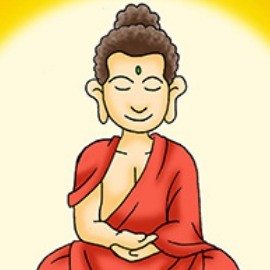THE RIGHT VIEWS

In the beginning there is the idea. The seed from which all else germinates. In spiritual practice, the view we hold of the world is certain to dictate the course of our actions. In Buddhism, the path of right view or right idea begins with a basic understanding of the spiritual laws of existence.
The noble four fold truths:
- that to be alive is to experience dissatisfaction
- that this dissatisfaction is borne of attachment to desire
- that these desires can be extinguished
- through following the eight fold path.
The first noble truth is usually interpreted as to be alive is to suffer. However, the original Pali word "dukkha" is a little more complicated than simple suffering. It really means a basic underlying unsatisfactoriness with existence, a psychological tension. Buddha never taught that life itself was inherently suffering, but that to be alive with a mundane consciousness was to be in a state of tension with existence. Of course suffering is an experience all living things share, because the nature of life is finite and when we experience the limits of our finiteness, we experience suffering.
Sickness, old age, and death visit every being born in this world. They are the borders of our own mortality. They do not inherently carry with them a measured level of suffering as each person, according to their own karma, experiences a different level of discomfort when confronted with their own mortality.
For instance, two people may break their legs skiing, with an identical level of physical pain and discomfort involved. One person may accept this accident gracefully, being mature enough to realize that when he or she choose to take up skiing, potential injury was part of the package. That person might spend the rest of the trip in the lodge, enjoying some wine and good company and making the most of it. A less mature individual could well be sent into a frenzy of anger at the "injustice" of their accident. This type of person will suffer a psychological hell of their own making and their experience of this hell is much worse than the pain of the injury and discomfort of a cast.
The essential difference in experience of two people sharing an identical misfortune is due to the excessive desire of one, versus the acceptance of the other. The worst part of this scenario for the angry skier is that they are likely to suffer more in the future because of their inability to deal with their situation. They bring this on themselves by arousing the contempt and anger of their companions because of their childish behavior. This in turn makes them bitter, full of self hatred, and more likely to repeat their mistakes in the future.
The source of their problems lie not in their experience, but in the view they hold of the world that made that experience so hellish. It is the natural consequence of being out of touch with reality. The basic idea or view of such a person stripped down to its essentials is that the world should conform to their expectations. This is a world view driven by desire, rather than acceptance.
Many westerners view acceptance as a kind of moral cowardice. In the words of Dylan Thomas, "Do not go gentle into that good night, but rage; rage against the dying of the light." The truth is, acceptance is not a passive state as opposed to desire. This is one of the misunderstandings inherent in modern world views. Acceptance is a conscious awareness of the reality of ones situation and does not imply a lack of energy. Acceptance is grounds for action because it deals realistically with the actual. Attachment to desire is a type of frenetic non action in that it ignores actuality in favor of a denatured possibility.
Understanding and acceptance of reality is the beginning of enlightened activity. In order to pursue a goal, we must have a grasp of what the conditions are that will shape the direction of our efforts. If we do not recognize the terrain, we will be unable to follow the map. Knowing this, Buddha systematically delineated the forces that shape life and consciousness. His interest was not in presenting a philosophical system, but in laying out a road map of the terrain of the human condition in order that we might find our own way. Hid teaching was an expression of his own experience, rather than a philosophical agenda handed down to him from tradition. The power of this teaching arises directly from its unconditioned freedom. This freedom can only be obtained, when one has the courage to pioneer into the self without the aid of a wagon full of philosophical given and theological speculations.
The Buddha's teaching was, and still remains, an intensely personal confrontation with the problem of human suffering and its alleviation. This confrontation with suffering was even more remarkable when we consider that Shakyamuni's profound distress with the human condition was not generated by his own personal suffering so much as his recognition of the suffering of those around him. The prince in his palace was moved by the sickness, old age, and death he saw around him while he himself remained free from these afflictions.
It was not just the knowledge of his own potential suffering that moved him, but the reality of suffering as a given in life that shook him to his foundation. For the truly spiritual , the reality of suffering abides in ones spirit as an enduring flame of compassion. This is a fire that burns away all distinction of self and other. It reduces all lesser considerations to ashes once it is kindles. Therefore, Buddha adamantly refused to answer questions that were purely theological or metaphysical as being inherently irrelevant.
His teaching had only one priority; the alleviation of human suffering. Even a simple person can recognize that there is no way that a human being can avoid these conditions which produce suffering on a physical level. As long as a man exists in a physical form, he has the consequences of that form. To have form one must have limit. For that which is without limit is by nature formless. To move in a world of limits is to experience limit in oneself, and the personal experience of limit is by nature an unsatisfactory experience to one who defines himself by his limits.
In the very beginning of life, physical pain and psychological frustration mark the infant's first confrontation with its limits. It experiences directly the unsatisfactory nature of its limits in its initial movements in the world. The bumped head, the toy just out of reach, reinforces a sense of powerlessness in the infants mind. This inability to have our own way, and the tension that it produces with the world, is what is meant in Buddhism as the first noble truth; that life is suffering.
The original word Buddha used was dukkha, a Pali term that, as I have said, implies more than the English word suffering. Dukkha refers to a type of underlying tension or dis-ease with existence. It describes the continuous confrontation of the individual with his limits. There is nothing particularly revolutionary about this insight, except for the subtleness of the definition. Buddha, however, then goes on to postulate another truth which begins to mark his radical departure from ordinary perception. Suffering is caused by desire, and this is the second noble truth.
Once again the actual Sanskrit word signifies more than the English word desire. Obviously there are many positive desires which are not productive of suffering, such as the desire to enlightenment, or to aid others, etc. What differentiates negative desires from positive desires is the clinging attachment associated with negativity. This energy is called Klesha or defilement in Pali, signifying an obsessive energy which bonds the individual to a concept of self or situation which will not allow one to confront limit with equanimity or acceptance.
Dukkha and klesha are like two ends of a magnet; dukkha is the energy that repels limit, while klesha energy is constantly drawing limit toward itself and bonding to it. Dukkha is unable to simply be, within the boundaries of personal existence, without pushing away continually from life situations, trying to manipulate its way into a position of power. It does this because the mind is constantly attracted to limit by the energy of klesha's magnetic pull. The clinging desire to be or abide in something of our own choosing, pulls one constantly forward toward various life situations. These are invariably unsatisfactory, in that they cannot appease the energy of desire, and thus we are repelled by them in the moment by the force of dukkha.
The attachments of desire attract us, and the unsatisfactoryness of the experience of our finiteness when we approach the object of desire repels us again. We are thus ceaselessly driven back and forth emotionally in a maelstrom of unhappiness. We can actually become so used to this situation that we learn to accept it, and not even recognize our own existential turmoil. A man who has been in pain since birth, believes he is quite happy until someone comes along and alleviates his pain. Then he recognizes for the first time what it is to be happy. The source of this klesha which causes suffering lies in a basic misunderstanding of the nature of self. This lack of understanding is what the Buddha called ignorance. The man that is ignorant sees himself as an absolute other, and carefully defines his limits, thus activating the energy of the kleshas and the resulting experience of suffering.
According to Buddhist teachings, the fundamental Reality of the Universe, the Buddha Mind, is none other than our own original nature. This nature is hidden from us due to the conditioning of desire and attachment to the process of becoming. This is the point where ignorance, in the form of attachment to self, keeps us from seeing our true nature. We literally are unable to see the forest for all of the trees, and yet there is no forest other than these trees.
The result of practicing the eight fold path is to begin to see each tree or component thing for what it is, a perfect expression of time and space. Every tree in the forest becomes a mirror to the process of becoming, reflecting the forest itself. All of life becomes merged in mutual identity at this subtle level of understanding. This is the result of a change of perspective that allows a perception of reality as a dynamic whole, rather than a set of ontological structures in a linear causal relationship.
For instance, our usual understanding is that a tree is an adaptation of a specific organism to a unique time and space. This is a linear perspective, however, and does not see the tree for what it is. It ignores the tree's interaction with the rest of the environment. A tree is a dynamic process rather than a concrete unit of being. That we perceive it as such is because of the limits imposed upon our senses by their very structure, and the corresponding interpretation by our mind.
In other words, our eyes are able to perceive light reflected from a source within the limits imposed by the visible spectrum. Although we are aware scientifically of other radiations such as infrared and ultraviolet light, we are unable to perceive them. Though the energy of light is composed of undulating patterns or waves, our perception of change is limited to only rapid transformation. We can see this clearly when we look at a time lapse film of a garden flower.
What appears to our ordinary consciousness as a rose in bloom is actually a rose in process. Through time lapse photography we can see the crest and trough of the energy of the rose bush as it generates buds, blooms, drops flowers, and begins again, all while it continues growing. Along with all the visible manifestations of process, are the myriad aspects of its interaction with the other forces of the garden. The rose interacts with the soil, absorbing nutrients, dropping leaves and flowers, which recycle nutrients, hosting insects, the insects feeding each other, and absorbing carbon dioxide and releasing oxygen.
Nothing about the rose is static. In fact, its very being is in interaction. Our consciousness defines it as a thing, however. A unit which is separate from the other units in the minds arena. It is either experienced as foreground or background. When the mind contemplates a garden, it delegates the rose to the role of background, and when it considers the rose itself, the sky or the garden wall becomes background. The reality of rose, however, is in its interaction with its environment. The names rose, garden, sky, and earth are mere tools of the intellect and communication having no real relationship to the reality of the phenomenon itself. This is always a matter of mutual interaction or better put, interpenetration.
The Buddhist term "mutual interpenetration", recognizes the absolute coincidence of being that is an environment. Every aspect of the garden is effecting and being effected by all other aspects simultaneously. The evidence of this reality is recognized in many disciplines from ecology to particle physics. The essential point for a Buddhist is that his own being is also sharing in this interpenetration. There is no abiding reality of self outside of this interpenetration; no permanent soul, mind, or spirit that is not one with this eternal interchange.
The process is being, there is nothing else. Ideas about self are irrelevant to the truth. They are mere clouds over the garden, coming into being and dissipating. All the while the constant stream of interaction goes on. As clouds blow where the wind takes them, so the dharma student allows ideas of self-freedom to blow across the sky of this eternal mutual interpenetration.
The forest is the trees and the trees are the forest. The rose is the garden, and the garden the rose. Others are the self, and self is the other. There is nothing other than this, nothing to cling to and nothing to fear. For if all is self, then there is no self which can be threatened by other.
How is it possible, then, for a person to operated effectively in this world of things holding this lofty view of mutual interpenetration? It is possible because each phenomenon, though sharing an essential being with all other phenomena, never the less maintains its own pattern or structure as an expression of this interrelationship. Things do not cease to exist when we become aware of their essential emptiness of self. If they did, then all existence would vanish with them. The process of this awareness can be found in the Zen saying, "First there is a mountain, then there isn't a mountain, then there is."
When we first see things we see them as absolute concrete realities in themselves. A mountain is a mountain and nothing else. Then we become aware of the mountain's essential emptiness, that it does not exist outside of its interrelationship with the world. Finally, it becomes mountain again when we see it with the enlightened eye as the perfect expression of the universe as mountain. In the final vision, it is no longer other, but participates with us in the mutual being of the moment.
We do not sacrifice anything by attaining this enlightened perspective. We are still able to function in the world of things with the same facility as before. We use reason and discrimination in our daily lives with even more adroitness than we did when we saw each thing as a reality onto itself. Now we understand on a visceral level that there is no action we take that does interact with the whole. Impetuous and stupid actions we would have taken before, thinking them to be in our self interest, are now seen for what they are.
For the first time we can trust our intuition to be a full partner with our reason in determining life's action. This is because there has been a fundamental turning round of consciousness which allows intuition to flow directly from that shared being which is the universal consciousness. Before intuition was crippled by the mind's obstinate adherence to a conception of the world of things separate in being.
We can begin to move through the world with the grace of a virtuoso who, having attained technical mastery of his instrument, can now let his intuitive genius flow into the symphony of life, but with our own unique touch and accent. The old view of self, which we believed gave us a sense of freedom, actually held us back from experiencing the beauty of our life. This beauty is what we call the Buddha Nature; it is the harmony of life of which we are one note. This view of life which recognizes the Buddha nature and the laws of spiritual reality is what is called Right View.




























